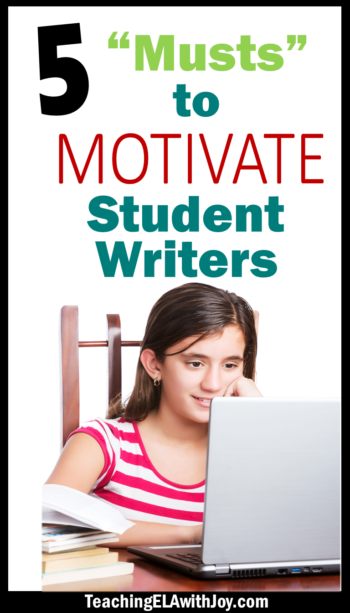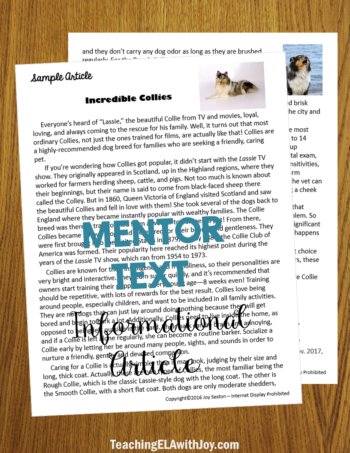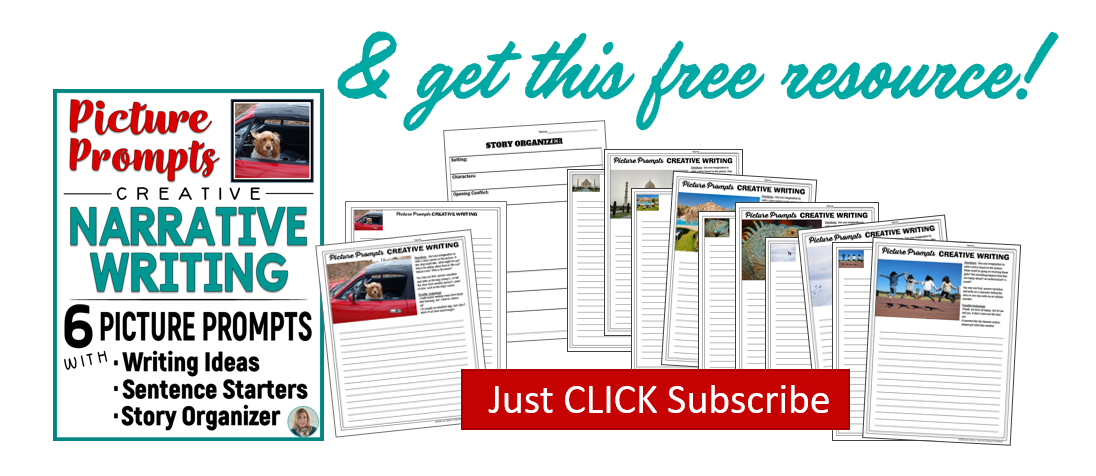Do your students get excited about writing? I’m thinking that, generally, the answer is not a resounding YES! And who would blame them, with all the emphasis on that scripted writing for state tests.
While teaching the formulaic essay is unavoidable, hopefully, we are allowing our kids practice with many types of writing. Journal entries, scripts/written conversations, business, friendly, and thank-you letters, and all types of poems are great options to offer as daily writing tasks. These can be fun and creative! And, you’ll be addressing the standard that asks students to write routinely over shorter time frames for a variety of purposes.
But when it’s time for lengthier writing that involves research, how can we ward off the moans and sighs from our students? For starters, we need to make the assignments seem appealing! Read on for strategies that will spark some enthusiasm for writing.
5 “Musts” to motivate student writers
1. Students are so much more engaged when you leave topic choice up to them. Let them write about something they would like to know more about. Most likely, you’ll need to demonstrate how to brainstorm some topics of interest. Then show students how to narrow down a topic if they’ve chosen something too general (like basketball or Puerto Rico).
Here’s a simple way I do this with students: Students make a 9-square chart with three topic possibilities across the top. Then below each topic, they narrow down to a more specific topic, and once more below that, get even more specific. Now they circle their top choice from these final topics (the bottom row) and still have two back-up topics just in case. Model this process right along with them as you create your own topics chart.
2. Students are much more eager to write if they don’t have to use a formal essay format. I find that students can meet all the standards for informational writing by writing articles, not essays. I specifically stress, “You get to write an informational article, not an essay!”
In fact, I get their attention by starting out with a stack of magazines in front of me, and I open up a Sports Illustrated for Kids and find a good article. I hold it up and start reading a bit, and then ask, “What makes this an article?” After some sharing, I ask, “Is this also an essay?” That sets up some discussion of the differences. Then I ask, “Where do we find essays?” That one always stumps the students—suddenly it’s quiet. We concur that essays are not really authentic, or “real-life” writing. We categorize them more as “school writing” (though I explain the relevance of scholarly essays in medicine, etc.).
So when I let students know that we will be writing articles, they feel more positive about writing! They can express themselves more creatively, yet they still practice all research and informational writing standards. The articles contain paragraphs with information presented in a clear and logical order.
The same positivity happens when I assign students my shorter Research Q & A writing task. Students conduct research on a topic of their choice (that they’ve narrowed down), but this time the information is presented in a fun Q & A format. They brainstorm and decide on two open-ended questions to research. Students type their findings on an editable template and import related images. The writing is organized in clearly-written paragraphs, and plenty of informational writing and research standards are met.
3. Motivate student writers by requiring something they love: images. You know those students who rush to upload the visuals before even starting the writing? Yes, students are drawn to image scrolling! If you want to make any writing assignment more appealing, definitely require some visuals. If you don’t want a picture to take up half of a page, it’s easy to require a few small images out in the margins or embedded into the edges of text. And don’t forget your artists, who would prefer to draw their images. It’s always nice to offer that as an option.
4. Student interest definitely increases when you display a stellar completed example (mentor text). Do this right at the time you’re introducing the assignment. That way, your students will visualize the expectations of the task. The colorful visuals on the mentor text will pull all eyes front and center. Only a brief look at the mentor text will be needed at this point. Let students know that this is what their completed work will resemble. Assure your students that they will examine this mentor text more closely later in the writing process.
Whether working one-on-one or with small groups, using a mentor text can bolster struggling writers tremendously during drafting and revising. When they get stuck or need support, a well-written example provides so many teachable moments.
5. Enthusiasm for writing will heighten when students understand how their writing will be shared with an audience. There’s always excitement when students see their work published! When you introduce the assignment, let them know exactly how this will happen.
I like to have a whole wall reserved to display student writing. An area out in the hallway and on the door is good too! I’ve even pre-arranged for displays in the library. Besides displaying work, you can also have class read-arounds. Just start with a finished product on every desk, and have students read and pass every 2-3 minutes.
Some years I place student writing in a clear-cover binder, using clear plastic sleeves. A student will design a cover page for the binder (Feature Articles, Hobbit Poems, etc.), and I leave them out for students to read. If you’re good with technology, students can share their work on digital bulletin boards or blogs.
Aligning Writing Tasks with Standards
When you assign a writing task, remember that you don’t have to meet every single standard. If your students are researching, using technology, citing sources, and following the writing process, you will certainly be addressing a large number of them! You can get creative in the form of your product as long as you keep an eye on standards and are able to check off several.
Meanwhile, if you incorporate these five essential elements that motivate student writers, your assignments will be enticing! Even if you can’t always hit on all five (at some point we must teach those essays), include the other four and any other winning “musts” you’ve discovered. Here’s to more writing positivity and student success in the months ahead!
If you’d like to save time, check out my Research Project – Writing an Informational Article. You’ll find everything you need to lead your students through the research and the writing, either with paper or digital slides. It includes an awesome mentor text, of course requires images, is very organized, and you’ll hit so many standards!
For more tips on helping students who may struggle with writing, read my post: 10 Ways to Make Essay Writing Less Stressful and More Successful






Leave a Reply